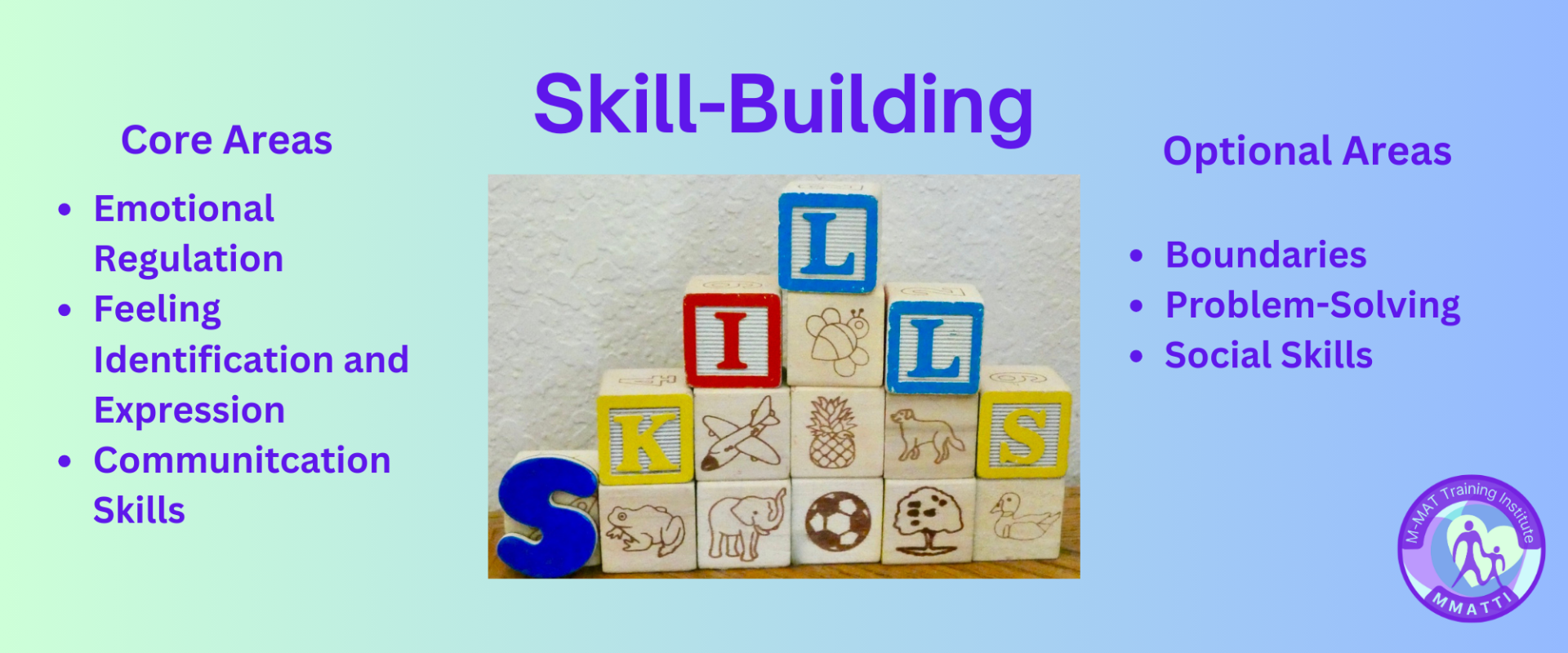
Skill-Building in
M-MAT
These activities are great for in session and in the home.
In M-MAT Skill Building is always done with the parent/caregiver and child together (Unless there is no appropriate caregiver and you are doing M-MAT Individual), because the primary focus is ALWAYS on relationship building.
Skill-buiding in areas impacted by trauma and attachment injuries is just one part of the M-MAT Model. By including parent and child together, we quadruple the impact and effect of this component. (OK, this statement has not been researched yet, but you get the idea 😉 ).
Here are a few reasons why engaging in skill-building activities together with both the parent and child is important:
3) Modeling and Imitation:
4) Promoting a Sense of Belonging:
5) Secure Base for Exploration:
7) Generalizing Learned Skills:
M-MAT
These activities are great for in session and in the home.
In M-MAT Skill Building is always done with the parent/caregiver and child together (Unless there is no appropriate caregiver and you are doing M-MAT Individual), because the primary focus is ALWAYS on relationship building.
Skill-buiding in areas impacted by trauma and attachment injuries is just one part of the M-MAT Model. By including parent and child together, we quadruple the impact and effect of this component. (OK, this statement has not been researched yet, but you get the idea 😉 ).
Here are a few reasons why engaging in skill-building activities together with both the parent and child is important:
1) Enhanced Communication and Bonding:
Joint activities create opportunities for positive interactions and shared experiences. Communication during these activities strengthens the parent-child bond, fostering a secure attachment. The emotional connection developed through shared activities lays the foundation for effective communication and understanding between parent and child.
2) Emotional Regulation:
Skill-building activities often involve facing challenges and problem-solving. When a parent and child work together to overcome obstacles, it promotes emotional regulation. The child learns to manage stress and frustration with the support and guidance of the parent (co-regulating), contributing to the development of emotional regulation.
3) Modeling and Imitation:
Children learn not only through explicit teaching but also by observing and imitating their parents. Joint skill-building activities provide an opportunity for parents to model skills, behaviors, and problem-solving strategies. Children, in turn, can imitate and internalize these behaviors, contributing to their overall development. For children with attachment injuries, this normal process of learning from their parents in this way may have been disrupted early in their life, and this provides an opportunity to re-establish this.
4) Promoting a Sense of Belonging:
Engaging in activities together reinforces the sense of belonging and connection within the family unit. A secure attachment fosters a child's sense of being loved, valued, and an integral part of the family, contributing to a positive family identity.
5) Secure Base for Exploration:
Attachment theory posits that a secure attachment provides a child with a secure base from which to explore the world. When parents and children engage in skill-building activities together, it reinforces the sense of security and support, allowing the child to explore and learn with confidence.
6) Building a Positive Self-Concept:
Through shared activities, parents can provide positive feedback and reinforcement, contributing to the child's developing sense of self-worth and competence. When children experience success in joint endeavors, it positively influences their self-concept and confidence.
7) Generalizing Learned Skills:
It will be easier for the child to generalized the skills to the home environment when they have practiced with their parent, and parent and child will have a shared language and experience, allowing the parent to support the child better in implementing skills.
8) Increasing Motivation and Reducing Shame:
Because the parent is learning the skills right with them, the child may feel less singled out, less the "identified patient", and they may be more motivated to engage in skill-building activities.
9) Parents Can Benefit From the Skill-Building as Well!
Parents and adults can equally benefit from the skills, improving functioning of the whole family unit!
In summary, engaging in skill-building activities together aligns with the principles of attachment theory by reinforcing the parent-child bond, creating a secure base for exploration, and promoting positive emotional and social development. These shared experiences contribute to the formation of a secure attachment, laying the groundwork for the child's overall well-being.
Skill Building Activities- Core Areas
Emotional Regulation
Breathing together - practice breathing with therapist, parent and child holding hands. The parent and child follow the therapist as the therapist raises their arms up and breathes in, then lowers their arms down and breathes out. The raising and lowering of the arms helps encourage diaphragmatic breathing. This exercise also allows the therapist to easily pace the breathing, while the hand holding and synchronizing of the breath with parent and child are nice attachment pieces.
Flower and candle - Have the child and parent practice breathing in through their noses, as if they are smelling a flower, and breathe out through their mouths, as if they are blowing out candles.
Breath counting: Count child and parent through breathing, “In two three four, hold two three four, out two three four.”
Progressive Relaxation - Attachment-injured children are often too anxious to participate well in guided imagery relaxation, but progressive relaxation, with the focus on tightening and relaxing various muscles moving up and down the body, can be effective.
Five Things - This is a mindfulness exercise that uses the senses to help a person get grounded and focused in the here and now. It can help reduce anxiety and help a child move away from being triggered. Have the child say five things they see, without thinking about it, just what they see at the moment. It is OK to repeat. Then five things they hear. Then five things they feel. The child then says four things they see, hear and feel. Then three things, then two, then one. If five things seem like too many for the child, you can start with three things. The therapist and parent can model for the child.
Physical Exercise - Physical exercise can help the child regulate in the moment and over the long term. Work with parent and child to identify physical activity that the child can engage in regularly and specific things they can do when the child finds themself getting frustrated or tense, such as jumping jacks or running around the yard. Practice in session when appropriate.
Sensory Activities - Some children may find running their hands through sand or dry beans or another medium soothing. Rubbing a soft piece of velvet or a smooth stone might bring comfort to other children. Some children may calm with a weighted blanket. Work with the parent and child to identify soothing sensory activities. You, parent and/or child can create a sensory kit for the child if desired.
Feeling Identification and Expression
Feelings Charades - Have a list of eight to ten feelings for all to see, for reference, and cards with those same feelings on them. Have each person, in turn, pick a feeling card, and act out that feeling while the others try to guess the feeling.
Feelings Matching Game - Have pairs of feeling cards. Mix them up and place them face down. Like any memory game, take turns picking pairs and trying to find a match. If someone gets a match, they share a time when they felt that way, and they keep those cards. They can choose not to share a time they felt that way, but then they have to put the cards they picked back where they got them. Contrary to other memory games, if the person gets a match, they do not go again. The play passes on to the next person so that more people get turns. Sometimes a child may purposely not pick matches to avoid sharing feelings. In this case, use the Feeling Cards game, described below, the next time.
Feeling Cards - Have a set of feeling cards. Spread the cards with just the backs showing and have the parent pick a card. The parent then tells the child a time they felt that way, starting with, “I felt happy when…” Then the child tells the parent a time they felt that way. Next turn, the child picks the card, but, again, both parent and child tell about a time they felt that way. The play goes back and forth until all the cards are gone. The therapist can also participate if it would help to model for the child and/or parent. This activity can be extended to include reflective listening skills described further in communication skills.
Feeling Cards In-the-Moment - Use the feeling cards during the session. Once the child is familiar with the cards, they can be used in the moment to help the child express themselves. For instance, if the child experienced a difficult event during the week, the therapist can pull out the feeling cards and go through them one by one, asking, “Did you feel (emotion) when that happened?” and separating out the cards that they acknowledge. At the end, the therapist can reflect back the feelings, “Oh, so you felt sad and mad and scared when…” The therapist can further help the child explore their feelings by asking further questions like, “What was scary about that for you?” or “What was the saddest part for you?” It can also be a good opportunity to talk about mixed feelings and how one often has several different, and possibly conflicting, feelings at the same time.
Once the therapist has modeled this for the parent, they can encourage the parent to do this with their child, both in the session and at home.
Emotion Commotion Game - https://emotioncommotiongame.com/products/emotion-commotion-game
A very fun game for exploring emotions!
Communication Skills
Reflective Listening Skills - Have the child tell the parent a time they had fun, starting with, “I had fun when…” Have the parent reflect back what they heard, starting with “I heard you say that you had fun when…” Let the child confirm or clarify. Then have a parent say a time they had fun and coach the child to reflect back in the same way. Early in the therapy, start with easy/comfortable feelings like fun, happy, excited. When the child and parent seem ready, the therapist can include more challenging feelings like sad, mad and disappointed. The therapist can have the parent and child pick from feeling cards to determine which feeling to use. Always be sure the child and parent reflect the feeling they heard when reflecting back to the other.
In-the-Moment Coaching - The reflective listening skills exercise gets the child and parent ready for in-the-moment coaching during other discussions to use these skills. For instance, a child might express anger about something that happened in the home. The therapist can then coach the parent to reflect back what they heard the child say before responding themselves, and vice versa. This can help facilitate understanding between parent and child and can sometimes slow down an otherwise volatile conversation.
Connection Questions - https://emotioncommotiongame.com/products/connection-questions
A great set of child/age appropriate prompts to stimulate communication between parent and child.

M-MAT Training Institute ~ MMATTI
The Goal? To provide training for therapists to support healing for children and families.
MMATTI Courses and Community are not a substitute for clinical supervision or consultation.
Copyright © 2025

